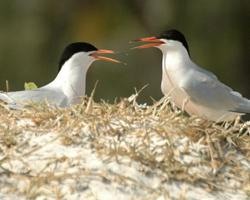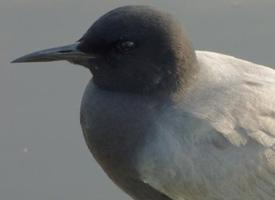
Statut de conservation
| Menacé |
Description de l'animal
The Roseate Tern, scientifically named Sterna dougallii, is a slender, medium-sized seabird that belongs to the Laridae family, which encompasses gulls, terns, and skimmers. This species is particularly noted for its graceful flight, elegant appearance, and the striking contrast between its pale plumage and the vibrant environment it inhabits. It has garnered attention not only for its beauty but also for its conservation status, as its numbers have faced declines in various parts of its range due to habitat loss, human disturbance, and other environmental pressures.Adult Roseate Terns exhibit a distinctive appearance, especially during the breeding season. They possess a predominantly white body that gleams under the sun, complemented by a pale grey back and wings. The tail is deeply forked, a characteristic feature of terns, and is used with adept precision in their aerial maneuvers. One of the most captivating features of the Roseate Tern is its long, slender bill, which is black with a red base, though this coloration can vary slightly. The legs are also red, adding a subtle yet striking contrast to its overall appearance. During the breeding season, adults display a black cap that extends from the bill to just beyond the eyes, giving them a masked look. However, this black cap fades to white outside the breeding season, leaving just a patch around the eyes.
The Roseate Tern's call is another characteristic trait, described as a high-pitched, vibrant "kik-krrr" or "keer-keer," which can be heard over the colonies where they nest and feed. These sounds add to the lively atmosphere of their breeding grounds, which they share with other seabird species.
Breeding and nesting habits of the Roseate Tern are fascinating. They prefer to nest in colonies on sandy or rocky islands, often alongside other tern species, but they maintain a certain distance to avoid competition. The nests are simple scrapes on the ground, sometimes lined with bits of vegetation or shells. They typically lay one to two eggs, which both parents incubate, taking turns. The chicks are precocial, meaning they are relatively mature and mobile from the moment of hatching, but they still rely on their parents for food and protection.
The diet of the Roseate Tern primarily consists of fish, which they catch with remarkable aerial dives into the water. Their diet is occasionally supplemented with crustaceans and insects, showcasing their adaptability in foraging.
Globally, the Roseate Tern has a widespread distribution, with populations found in the Atlantic and Pacific Oceans, the Caribbean, and parts of the Indian Ocean. Despite this broad range, the species is considered globally threatened due to habitat degradation, human disturbance, and predation by introduced species on nesting grounds. Conservation efforts are in place in several regions to protect their breeding sites, manage predator populations, and monitor the species' numbers to ensure their survival.
In summary, the Roseate Tern (Sterna dougallii) is a remarkable seabird known for its striking appearance, elegant flight, and complex behaviors. Its conservation status underscores the importance of ongoing efforts to protect these birds and their habitats, ensuring that future generations can continue to marvel at their grace and beauty.
Animaux similaires
Nouvelles photos d'animaux
Top 10 des animaux
- Dolphin gull (Leucophaeus scoresbii)
- Diana monkey (Cercopithecus diana)
- Moustached guenon (Cercopithecus cephus)
- Galápagos tortoise (Geochelone nigra complex)
- Stone loach (Barbatula barbatula)
- Japanese macaque (Macaca fuscata)
- Russian tortoise (Testudo horsfieldii)
- Greek tortoise (Testudo graeca)
- Common flying dragon (Draco volans)
- Vendace (Coregonus albula)


